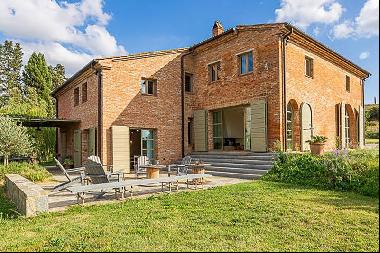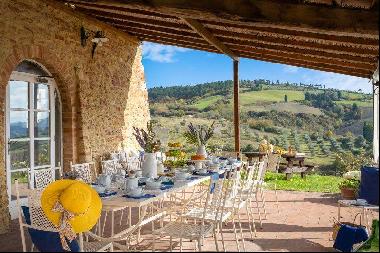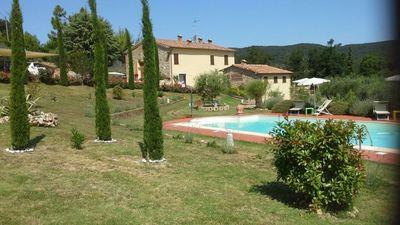For Sale, PRICE UPON REQUEST
Tuscany, Italy
Property Type : Farm/Ranch/Plantation
Property Style : N/A
Build Size : 175,225 ft² / 16,279 m²
Land Size : N/A
Bedroom : 50
Bathroom : 30
Half Bathroom : 0
MLS#: N/A
Property Description
In the province of Florence, on the Chianti Hills, prestigious historical estate with manor villa and winery.
In an easily accessed location, not far from a center with all the services (6km; 10'), the property grants a quick and excellent access to the whole Tuscany: the beautiful Florence (25km; 40'), the turreted San Gimignano (76km; 1h 20'), Siena (84km; 1h 25'), the renowned Montepulciano (95km; 1h 15') and Montalcino (122km; 1h 45') and the papal Pienza (102km; 1h 25').
The airports to reach the property in reasonable time are Firenze Peretola (49km; 45'), Pisa Galilei (109km; 1h 25'), Bologna Marconi (130km; 1h 35'), Perugia Sant'Egidio (145km; 1h 40'), Roma Ciampino (273km; 2h 45') e Roma Fiumicino (288km; 2h 50').
DESCRIPTION OF THE BUILDINGS
The property is made up of numerous buildings (17 for a total surface of 15,500 sqm) split among the various farms. Icing on the cake is the historical manor villa, constituting the older core of the property dating back to the 11th and 14th century. This hamlet, beyond the villa, includes a late Middle Ages church, an olive mill, several cellar rooms, office for the business, a workshop and one of the farms.
The other five farms include several buildings intended for agricultural and residential use, partially to be restored partially already restored and almost livable.
To summarize, the property boasts 11,000 sqm (118,360 sqft) of residential buildings, 3,000 sqm (32,280 sqft) of agricultural sheds and 1,500 sqm (16,140 sqft) of rural buildings.
HISTORY, STATE AND FINISHES
The estate lies on a land inhabited since Prehistory, but the first real civilization to build and use the region was the Etruscans starting from the 7th century BC. Romans would then pick up the legacy of the Etruscan people by building impressive villas and farms in the region. It was a prosperous age for the inhabitants, which were granted a good degree of autonomy. However this wasn't bound to last: the arrival of Germanic people from northern Europe after the fall of Rome in the 5th century AD dramatically changed the situation.
The feudal organization imposed by the Longobards severely reduced the independence for the people in the area and forced them to bow to the new conquerors.
After the end of the Langobardic reign, Tuscany was conquered and administered by Franks (and then Germans with the Holy Roman Empire) and in the 10th century a process of encastellation began on a large scale in the area of Florence and where the villa is sitting today.
The castle appears for the first time in a document dated 1080 AD and then in several other papers from 1102, 1123 and 1171 AD. The owners of the castle decided to abandon it when Florence started emerging as a superpower in Central Italy between 1140 and 1153. What is sure is that the people of the fiefdom took part in the Second Crusade in 1145 under the flag of Guido Guerra II. In the second decade of the 13th century the family decided to finally give up the castle by donating it to the nearby Abbey of Vallombrosa. After that, the castle was probably destroyed (or at least heavily damaged) by the Ghibellines armies following their victory in the battle of Montaperti in 1260 AD (recalled by Dante in the famous verses "[…] the slaughter and great carnage / which have with crimson stained the Arbia").
As testified by a document from 1427, by that year the castle had already been totally demolished and the remains used as a base for a new building (nowadays a farm) which was built between 1260 and 1420. However, the building was already in an advanced state of ruin and during the 17th century the new owners decided to restore the northern part of the complex which included the old tower (the only remain of the castle), obtaining a villa. When in the 19th century the property changed hands again, the rectory of the church was expanded and this allowed the conjunction of the villa with the farm. The last change (which is the one that made the complex look what it is today) was the relocation of the bell tower from the left to the right side of the church.
The property is currently abandoned for the most part and just a few of the buildings have been structurally reinforced and restored. The villa in particular is a real gem, covered as it is in frescoes and decorations; however it needs lots of work to be brought back to its original splendor. The church is also in bad shape, with the roof partially collapsed.
The other farms are mainly made up of rural and agricultural buildings (which are easier to recover and restore following the guidelines for historical buildings).
The cellar is currently working, as well as the olive mill, and both grant the regular production of olive oil and wines.
EXTERIOR
The property consists of a 236.2 hectares piece of land, split among vineyard (18.1 ha), olive grove (47.7 ha), arable land (82.2 ha), grazing land (7.8 ha), fruit orchard (2.6 ha) and mixed woodland (77.8 ha).
The vineyard is potentially expandable for further 27 hectares, taking some land from the arable plots (12 hectares of which had been used as a vineyard in the past). Same goes for the olive grove, which should be expanded with 8 more hectares thanks to the Rural Development Program which could cover up to 80% of the total cost.
The production of olives is totally organic (with certification), without the use of pesticides and chemical fertilizers, while vineyard hasn't got the certification yet, even if harvesting is carried out without using chemical substances. Manual harvesting and sorting of grapes contribute to the excellent quality of the wine.
DETAILS ON WINE PRODUCTION
- Vineyard surface: 18.1 hectares (+ 27.0 ha available for plantation)
- Varieties: Sangiovese, Cabernet Sauvignon, Canaiolo, Syrah, Malvasia and Trebbiano
- Year of planting: 1957 – 2011
- Altitude: 280 – 330 m
- Exposure: south, south-east, south-west
- Density: 3,500 – 5,000 vines / ha
- Average yield: 4.5 – 7.0 tons / ha
- Training: pruned-spur cordon-trained vines
- Harvesting: manual
- Soil composition: calcareous, marlstone, clayish
- Yearly production: 350.0 hl (46,700 bottles)
- Maximum potential productions: 1,425.0 hl (190,000 bottles)
- Maximum wine capacity: 1,870.0 hl
PRODUCED WINES
- Chianti Colli Fiorentini DOCG: 100% Sangiovese
- Chianti Colli Fiorentini DOCG Riserva: 90% Sangiovese, 10% Cabernet Sauvignon
- Rosso Toscano IGT: 40% Sangiovese, 30% Canaiolo, 20% Malvasia, 10% Trebbiano
- Rosso Toscano IGT: 50% Cabernet Sauvignon, 25% Merlot, 25% Syrah
- Bianco Toscano IGT: 50% Cabernet Sauvignon, 50% Chardonnay
DETAILS ON OIL PRODUCTION
- Surface: 47.7 hectares (+ 8.0 ha available for plantation)
- Varieties: Frantoio, Moraiolo, Leccino, Pendolino and Peranzana
- Altitude: 300 – 350 m
- Soil composition: calcareous, marlstone, clayish
- Yearly production: 90.0 hl (12,000 bottles)
USE AND POTENTIAL USES
The property is currently used exclusively as a wine and oil producing business, with a yearly production ranging around 46,700 bottles of wine (350 hl) and 12,000 bottles of oil (90 hl). Buildings are partially restored and usable without any work needed.
The estate is perfect for someone looking for something to develop in parallel with the oil and wine business. With a full restoration one could, as a matter of fact, think about starting a high quality hosting business, mainly thanks to the numerous available bedrooms and the panoramic position.
A conversion project has already been approved and envisages the realization of a hotel with restaurant, conference hall, oil museum, wellness centre, shop for local products, sporting facilities and the conversion of some of the farms into apartments.
As far as sporting facilities are concerned, there is the possibility of building pools and tennis courts with a limitation of one per group of buildings, with the exception of the main villa which is ample enough to allow the construction of both a pool and a tennis court in the vicinity.
CLOSEST CITIES AND TOWN†S
Town with services (6km; 10'), Figline e Incisa Valdarno (14km; 20'), Florence (25km; 40'), San Gimignano (76km; 1h 20'), Siena (84km; 1h 25'), Montepulciano (95km; 1h 15'), Pienza (102km; 1h 25'), Montalcino (122km; 1h 45')
CLOSEST AIRPORTS
Firenze Peretola (49km; 45'), Pisa Galilei (109km; 1h 25'), Bologna Marconi (130km; 1h 35'), Perugia Sant'Egidio (145km; 1h 40'), Roma Ciampino (273km; 2h 45'), Roma Fiumicino (288km; 2h 50')
More
In an easily accessed location, not far from a center with all the services (6km; 10'), the property grants a quick and excellent access to the whole Tuscany: the beautiful Florence (25km; 40'), the turreted San Gimignano (76km; 1h 20'), Siena (84km; 1h 25'), the renowned Montepulciano (95km; 1h 15') and Montalcino (122km; 1h 45') and the papal Pienza (102km; 1h 25').
The airports to reach the property in reasonable time are Firenze Peretola (49km; 45'), Pisa Galilei (109km; 1h 25'), Bologna Marconi (130km; 1h 35'), Perugia Sant'Egidio (145km; 1h 40'), Roma Ciampino (273km; 2h 45') e Roma Fiumicino (288km; 2h 50').
DESCRIPTION OF THE BUILDINGS
The property is made up of numerous buildings (17 for a total surface of 15,500 sqm) split among the various farms. Icing on the cake is the historical manor villa, constituting the older core of the property dating back to the 11th and 14th century. This hamlet, beyond the villa, includes a late Middle Ages church, an olive mill, several cellar rooms, office for the business, a workshop and one of the farms.
The other five farms include several buildings intended for agricultural and residential use, partially to be restored partially already restored and almost livable.
To summarize, the property boasts 11,000 sqm (118,360 sqft) of residential buildings, 3,000 sqm (32,280 sqft) of agricultural sheds and 1,500 sqm (16,140 sqft) of rural buildings.
HISTORY, STATE AND FINISHES
The estate lies on a land inhabited since Prehistory, but the first real civilization to build and use the region was the Etruscans starting from the 7th century BC. Romans would then pick up the legacy of the Etruscan people by building impressive villas and farms in the region. It was a prosperous age for the inhabitants, which were granted a good degree of autonomy. However this wasn't bound to last: the arrival of Germanic people from northern Europe after the fall of Rome in the 5th century AD dramatically changed the situation.
The feudal organization imposed by the Longobards severely reduced the independence for the people in the area and forced them to bow to the new conquerors.
After the end of the Langobardic reign, Tuscany was conquered and administered by Franks (and then Germans with the Holy Roman Empire) and in the 10th century a process of encastellation began on a large scale in the area of Florence and where the villa is sitting today.
The castle appears for the first time in a document dated 1080 AD and then in several other papers from 1102, 1123 and 1171 AD. The owners of the castle decided to abandon it when Florence started emerging as a superpower in Central Italy between 1140 and 1153. What is sure is that the people of the fiefdom took part in the Second Crusade in 1145 under the flag of Guido Guerra II. In the second decade of the 13th century the family decided to finally give up the castle by donating it to the nearby Abbey of Vallombrosa. After that, the castle was probably destroyed (or at least heavily damaged) by the Ghibellines armies following their victory in the battle of Montaperti in 1260 AD (recalled by Dante in the famous verses "[…] the slaughter and great carnage / which have with crimson stained the Arbia").
As testified by a document from 1427, by that year the castle had already been totally demolished and the remains used as a base for a new building (nowadays a farm) which was built between 1260 and 1420. However, the building was already in an advanced state of ruin and during the 17th century the new owners decided to restore the northern part of the complex which included the old tower (the only remain of the castle), obtaining a villa. When in the 19th century the property changed hands again, the rectory of the church was expanded and this allowed the conjunction of the villa with the farm. The last change (which is the one that made the complex look what it is today) was the relocation of the bell tower from the left to the right side of the church.
The property is currently abandoned for the most part and just a few of the buildings have been structurally reinforced and restored. The villa in particular is a real gem, covered as it is in frescoes and decorations; however it needs lots of work to be brought back to its original splendor. The church is also in bad shape, with the roof partially collapsed.
The other farms are mainly made up of rural and agricultural buildings (which are easier to recover and restore following the guidelines for historical buildings).
The cellar is currently working, as well as the olive mill, and both grant the regular production of olive oil and wines.
EXTERIOR
The property consists of a 236.2 hectares piece of land, split among vineyard (18.1 ha), olive grove (47.7 ha), arable land (82.2 ha), grazing land (7.8 ha), fruit orchard (2.6 ha) and mixed woodland (77.8 ha).
The vineyard is potentially expandable for further 27 hectares, taking some land from the arable plots (12 hectares of which had been used as a vineyard in the past). Same goes for the olive grove, which should be expanded with 8 more hectares thanks to the Rural Development Program which could cover up to 80% of the total cost.
The production of olives is totally organic (with certification), without the use of pesticides and chemical fertilizers, while vineyard hasn't got the certification yet, even if harvesting is carried out without using chemical substances. Manual harvesting and sorting of grapes contribute to the excellent quality of the wine.
DETAILS ON WINE PRODUCTION
- Vineyard surface: 18.1 hectares (+ 27.0 ha available for plantation)
- Varieties: Sangiovese, Cabernet Sauvignon, Canaiolo, Syrah, Malvasia and Trebbiano
- Year of planting: 1957 – 2011
- Altitude: 280 – 330 m
- Exposure: south, south-east, south-west
- Density: 3,500 – 5,000 vines / ha
- Average yield: 4.5 – 7.0 tons / ha
- Training: pruned-spur cordon-trained vines
- Harvesting: manual
- Soil composition: calcareous, marlstone, clayish
- Yearly production: 350.0 hl (46,700 bottles)
- Maximum potential productions: 1,425.0 hl (190,000 bottles)
- Maximum wine capacity: 1,870.0 hl
PRODUCED WINES
- Chianti Colli Fiorentini DOCG: 100% Sangiovese
- Chianti Colli Fiorentini DOCG Riserva: 90% Sangiovese, 10% Cabernet Sauvignon
- Rosso Toscano IGT: 40% Sangiovese, 30% Canaiolo, 20% Malvasia, 10% Trebbiano
- Rosso Toscano IGT: 50% Cabernet Sauvignon, 25% Merlot, 25% Syrah
- Bianco Toscano IGT: 50% Cabernet Sauvignon, 50% Chardonnay
DETAILS ON OIL PRODUCTION
- Surface: 47.7 hectares (+ 8.0 ha available for plantation)
- Varieties: Frantoio, Moraiolo, Leccino, Pendolino and Peranzana
- Altitude: 300 – 350 m
- Soil composition: calcareous, marlstone, clayish
- Yearly production: 90.0 hl (12,000 bottles)
USE AND POTENTIAL USES
The property is currently used exclusively as a wine and oil producing business, with a yearly production ranging around 46,700 bottles of wine (350 hl) and 12,000 bottles of oil (90 hl). Buildings are partially restored and usable without any work needed.
The estate is perfect for someone looking for something to develop in parallel with the oil and wine business. With a full restoration one could, as a matter of fact, think about starting a high quality hosting business, mainly thanks to the numerous available bedrooms and the panoramic position.
A conversion project has already been approved and envisages the realization of a hotel with restaurant, conference hall, oil museum, wellness centre, shop for local products, sporting facilities and the conversion of some of the farms into apartments.
As far as sporting facilities are concerned, there is the possibility of building pools and tennis courts with a limitation of one per group of buildings, with the exception of the main villa which is ample enough to allow the construction of both a pool and a tennis court in the vicinity.
CLOSEST CITIES AND TOWN†S
Town with services (6km; 10'), Figline e Incisa Valdarno (14km; 20'), Florence (25km; 40'), San Gimignano (76km; 1h 20'), Siena (84km; 1h 25'), Montepulciano (95km; 1h 15'), Pienza (102km; 1h 25'), Montalcino (122km; 1h 45')
CLOSEST AIRPORTS
Firenze Peretola (49km; 45'), Pisa Galilei (109km; 1h 25'), Bologna Marconi (130km; 1h 35'), Perugia Sant'Egidio (145km; 1h 40'), Roma Ciampino (273km; 2h 45'), Roma Fiumicino (288km; 2h 50')
HISTORICAL ESTATE FOR SALE IN FLORENCE - CHIANTI, Italy,Tuscany is a 175,225ft² Tuscany luxury Farm/Ranch/Plantation listed for sale PRICE UPON REQUEST. This high end Tuscany Farm/Ranch/Plantation is comprised of 50 bedrooms and 30 baths. Find more luxury properties in Tuscany or search for luxury properties for sale in Tuscany.




















